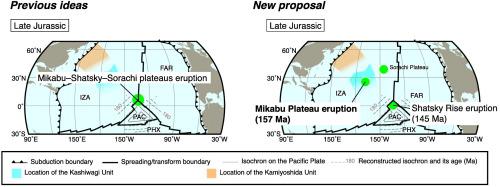当前位置:
X-MOL 学术
›
Gondwana Res.
›
论文详情
Our official English website, www.x-mol.net, welcomes your feedback! (Note: you will need to create a separate account there.)
Paleogeography of Late Jurassic large-igneous-province activity in the Paleo-Pacific Ocean: Constraints from the Mikabu greenstones and Chichibu accretionary complex, Kanto Mountains, Central Japan
Gondwana Research ( IF 6.1 ) Pub Date : 2021-01-01 , DOI: 10.1016/j.gr.2020.10.003 Kohei Tominaga , Hidetoshi Hara
Gondwana Research ( IF 6.1 ) Pub Date : 2021-01-01 , DOI: 10.1016/j.gr.2020.10.003 Kohei Tominaga , Hidetoshi Hara

|
Abstract The Mikabu Unit (Mikabu greenstones) was an oceanic plateau that was in the Mesozoic Paleo-Pacific Ocean. Large-igneous-province (LIP) activity has been proposed as the origin of the oceanic plateau of the Mikabu Unit. This study aims to reveal LIP activity in the Paleo-Pacific Ocean. We present geochemical and geochronological data for the Mikabu Unit and the Middle Jurassic to Early Cretaceous Chichibu accretionary complex (i.e., the Kashiwagi and Kamiyoshida units), both of which underwent the same high-pressure low-temperature metamorphism as the Mikabu Unit, in the Kanto Mountains, central Japan. The Mikabu Unit contains oceanic plateau basalts characterized by incompatible element depletion and high chondrite normalized Gd/Yb ratios. These basalts are interpreted to have erupted in the age of 157.0 ± 0.9 Ma (Late Jurassic), based on zircon U–Pb dating of anorthosite. The basalt geochemistry indicates that oceanic plateau basalts occur in the Kashiwagi Unit. Although basalts in the Mikabu Unit were thought to have formed at the Pacific–Izanagi–Farallon triple junction in the previous studies, we propose they formed on older oceanic crust of the Izanagi Plate during the Late Jurassic, which was located several thousand kilometers from the triple junction. The Kashiwagi and Mikabu units were accreted to Asia during the Early Cretaceous.
中文翻译:

古太平洋晚侏罗世大型火成岩省活动的古地理:来自日本中部关东山脉 Mikabu 绿岩和秩父增生复合体的约束
摘要 米卡布单元(米卡布绿岩)是位于中生代古太平洋的一个大洋高原。大火成岩省 (LIP) 活动已被提议为 Mikabu 单元海洋高原的起源。本研究旨在揭示古太平洋中的 LIP 活动。我们提供了 Mikabu 单元和中侏罗世至早白垩世 Chichibu 增生杂岩(即柏木和 Kamiyoshida 单元)的地球化学和地质年代学数据,它们都经历了与 Mikabu 单元相同的高压低温变质作用,在日本中部关东山脉。Mikabu 单元包含大洋高原玄武岩,其特征是不相容的元素耗尽和高球粒陨石归一化 Gd/Yb 比率。这些玄武岩被解释为在 157.0 ± 0.9 Ma(晚侏罗纪)爆发,基于斜长岩的锆石 U-Pb 测年。玄武岩地球化学结果表明,柏木单元有海洋高原玄武岩。尽管在先前的研究中认为 Mikabu 单元中的玄武岩形成于太平洋-伊邪那岐-法拉隆三重交界处,但我们认为它们在晚侏罗世期间形成于伊邪那岐板块的较旧的洋壳上,该地壳距太平洋几千公里。三联结。Kashiwagi 和 Mikabu 单元在早白垩世期间被增生到亚洲。我们推测它们在侏罗纪晚期形成于伊邪那岐板块较老的洋壳上,距三重交界处几千公里。Kashiwagi 和 Mikabu 单元在早白垩世期间被增生到亚洲。我们推测它们在侏罗纪晚期形成于伊邪那岐板块较老的洋壳上,距三重交界处几千公里。Kashiwagi 和 Mikabu 单元在早白垩世期间被增生到亚洲。
更新日期:2021-01-01
中文翻译:

古太平洋晚侏罗世大型火成岩省活动的古地理:来自日本中部关东山脉 Mikabu 绿岩和秩父增生复合体的约束
摘要 米卡布单元(米卡布绿岩)是位于中生代古太平洋的一个大洋高原。大火成岩省 (LIP) 活动已被提议为 Mikabu 单元海洋高原的起源。本研究旨在揭示古太平洋中的 LIP 活动。我们提供了 Mikabu 单元和中侏罗世至早白垩世 Chichibu 增生杂岩(即柏木和 Kamiyoshida 单元)的地球化学和地质年代学数据,它们都经历了与 Mikabu 单元相同的高压低温变质作用,在日本中部关东山脉。Mikabu 单元包含大洋高原玄武岩,其特征是不相容的元素耗尽和高球粒陨石归一化 Gd/Yb 比率。这些玄武岩被解释为在 157.0 ± 0.9 Ma(晚侏罗纪)爆发,基于斜长岩的锆石 U-Pb 测年。玄武岩地球化学结果表明,柏木单元有海洋高原玄武岩。尽管在先前的研究中认为 Mikabu 单元中的玄武岩形成于太平洋-伊邪那岐-法拉隆三重交界处,但我们认为它们在晚侏罗世期间形成于伊邪那岐板块的较旧的洋壳上,该地壳距太平洋几千公里。三联结。Kashiwagi 和 Mikabu 单元在早白垩世期间被增生到亚洲。我们推测它们在侏罗纪晚期形成于伊邪那岐板块较老的洋壳上,距三重交界处几千公里。Kashiwagi 和 Mikabu 单元在早白垩世期间被增生到亚洲。我们推测它们在侏罗纪晚期形成于伊邪那岐板块较老的洋壳上,距三重交界处几千公里。Kashiwagi 和 Mikabu 单元在早白垩世期间被增生到亚洲。



























 京公网安备 11010802027423号
京公网安备 11010802027423号